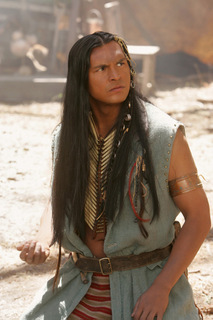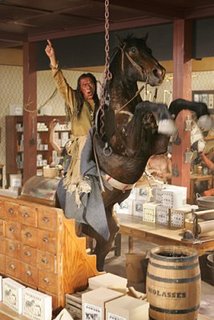. . .

As the opening credits roll, we see Wes Studi is the first Indian listed, in the ninth position. Adam Beach is next in the 10th position. It's a sign the Indians aren't going to be major players.
The show commences with a peace parlay set in the early 1800s. Under a white flag, Indians gather in a tent to hear some soldiers speak. These Indians wear standard-issue buckskins and live in teepees, but that's all we learn about them. They're generic Plains Indians.
Suddenly, more soldiers surround the tent and begin firing into it. Apparently they don't care if they kill their own men along with the Indians. A massacre ensues, leaving a little boy with a woman's blood on his hands. You can bet he's going to grow up to be one angry Indian.
Cut to northern Texas, 1858. The Comanches roam the Plains to steal horses and commit other crimes. The Texas Rangers roam the Plains to "contain" the Comanches. They're led by Inish Scull (Val Kilmer), Woodrow Call (Karl Urban), and Gus McCrae (Steve Zahn).
And...that's it for the geopolitical context in Comanche Moon. We're given no idea what motivates the Comanches. Have the whites offered them a treaty or given them a reservation? Have the Comanches refused to sign or settle down? Who knows?
It's pretty clear we're in classic Western-movie territory. The Indians are bad guys who rape and pillage without reason. They're savages.
We can summarize the plot of the first episode pretty quickly. A Comanche steals the prized horse of Captain Scull (Kilmer). Like an addled Don Quixote, Scull goes after his horse on foot, alone. A bandit captures him and holds him for ransom, and the other Rangers set out to rescue him.
Most of the action takes place on the Texas plains, as the Rangers hunt the Comanches. Back in the town of Austin, three women wait for their men to return. We can characterize them as a slut, a whore, and a tease—which tells you Comanche Moon's view of women will be no better than its view of Indians.

"Those torturing fiends"
Let's look at the Indians in Comanche Moon.
Wes Studi is Buffalo Hump, the leader of a band of Comanches. Adam Beach is his son Blue Duck. Blue Duck is your typical "brave on the warpath" who lives for his rage. He tries to kill Woodrow Call because Call killed his brother.
Kicking Wolf (Jonathan Joss) is the "best horse thief in the world" and Three Birds (Aldred Montoya) is his accomplice. These two actually seem intelligent. Unfortunately, they end up badly when they take Scull's horse to a Mexican bandit to trade. Kicking Wolf is tied to a horse and dragged over the ground, and Three Birds jumps off a cliff to avoid torture.
Ahumado (Sal Lopez), the Mexican bandit, is called "the Mayan," so he's an Indian too. And what an Indian. "He could do nothing but evil," Scull says of him.
When we first see Ahumado, he's having a man tortured for letting a horse die. If that isn't bad enough, he skewers three bugs on a stick and eats them. He also likes to put people in cages and suspend them until they die of starvation. Can you say "evil incarnate"?
Some unnamed Comanches burn a wagon, kill an old man and a boy, and capture a woman and girls. One Comanche says to take the captives to Buffalo Hump, but another wants to kill the woman now. Apparently he's already raped her. The Rangers arrive and save the females, but regard the woman with pity. The Comanches have already "had her" so no white man will want her.
The genocidal maniac
Finally, we return to Buffalo Hump. As we suspected, he was the boy whose people were massacred 50 years ago. After singing and talking to himself for days, he hatches a plan. "We will fight as one band," he says. "We will raid all the way to the ocean.
"We must fight the Texans and defeat them, now. Otherwise they will break us, and the way of the Comanche will disappear.

"In seven days, we go to the Great Water. We will kill every Texan that we find."
So the Comanches don their warpaint and set off on horseback. Not only will they raid and kill, but they plan to burn Call's and McCrae's town of Austin. "Now is the time of our revenge," says Buffalo Hump.
Huh? I must have missed the history lesson in which Indians attacked an entire town. I thought they limited themselves to isolated cabins and wagon trains.
Attacking small parties of whites could be seen as a counteroffensive—a justifiable form of self-defense. But attacking a town is an act of aggression, not self-defense. These Indians want to kill because the white man won't let them steal horses in peace.
In other words, they're the cause of the trouble. In Comanche Moon, white men are innocent and Indians are guilty. The show literally presents the conflict as one of civilization vs. savagery.
Buffalo Hump's only motivation is revenge for a massacre that occurred 50 years ago. That was before most of his followers were born. It's about as plausible as Indians going on the warpath in 1940 to avenge Wounded Knee.
Buffalo Hump is no Tecumseh, uniting tribes to gain peace through strength. In fact, he has no plan whatsoever. He's launching a race war against Texas and damn the consequences. If other Indians suffer the inevitable reprisals, well, who cares?
The only good Indian
Let's sum up the Indians we've met. There's Blue Duck the attempted assassin. Kicking Wolf and Three Birds the horse thieves. Ahumado the torturer. An unnamed Comanche rapist. And Buffalo Hump, the genocidal revenge seeker.
Other than speaking Comanche, these Indians show no evidence of culture. They have no religion, no beliefs, no ceremonies. They live to steal horses, capture women, and kill white men. Scull apparently describes them accurately when he calls them "those torturing fiends."
The only Indian who comes off well is Famous Shoes (David Midthunder), a Kickapoo scout for the Rangers. Not only is he clever and well spoken, but he seems to have an outside life. For instance, he talks of visiting his grandmother to hear more stories before she dies. And when he leaves Scull alone to tackle Ahumado (because unlike Scull, he isn't suicidal), he says he'll look for the hole from which the Kickapoo emerged.

So we have half a dozen bad Indians and one good Indian. And the good Indian is an aide to the enemy, a traitor to his race. Nice.
Comanche Moon has only a few saving graces. The main Indians get face time and emerge as individuals. Everyone has a plausible Indian name (no one is named after a bear or eagle). And the flat, empty plains are a welcome change from the usual landscape of mesas and canyons.
In short, Comanche Moon is your (stereo)typical Western series. It's mildly interesting to see actors such as Val Kilmer, Rachel Griffiths, and Wes Studi chew the scenery. But if that doesn't grab you, give it a pass. Rob's rating for part one: 7.0 of 10.
In fact, I suggest you read the graphic novel of the same name instead. Jack Jackson's COMANCHE MOON covers the same time and place but does a much better job of it. It's one of the best comics featuring Indians ever, and far superior to Larry McMurtry's work.
Reviewing the rest of Comanche Moon
Part two: Blue Duck the rapist
Part three: Bear-baiting and death-dealing
More on Comanche Moon
Comanches = full-fledged humans
"Comanche Heritage" in Comanche Moon
Comanches ruled an empire
Jonathan Joss in Comanche Moon
Cynthia Ann Parker in Comanche Moon
Criticizing Comanche Moon = PC?
Educating Russ about historical accuracy
King Lollipop in Comanche Moon
Sources for Comanche Moon
Dense, depraved, and diabolical
Comanche F-Troop
Studi on Comanche Moon
Stereotypes in Comanche Moon
Preview of Comanche Moon
Upcoming: Comanche Moon
Related links
The best Indian movies
TV shows featuring Indians
|
. . . |

|
All material © copyright its original owners, except where noted.
Original text and pictures © copyright 2008 by Robert Schmidt.
Copyrighted material is posted under the Fair Use provision of the Copyright Act,
which allows copying for nonprofit educational uses including criticism and commentary.
Comments sent to the publisher become the property of Blue Corn Comics
and may be used in other postings without permission.